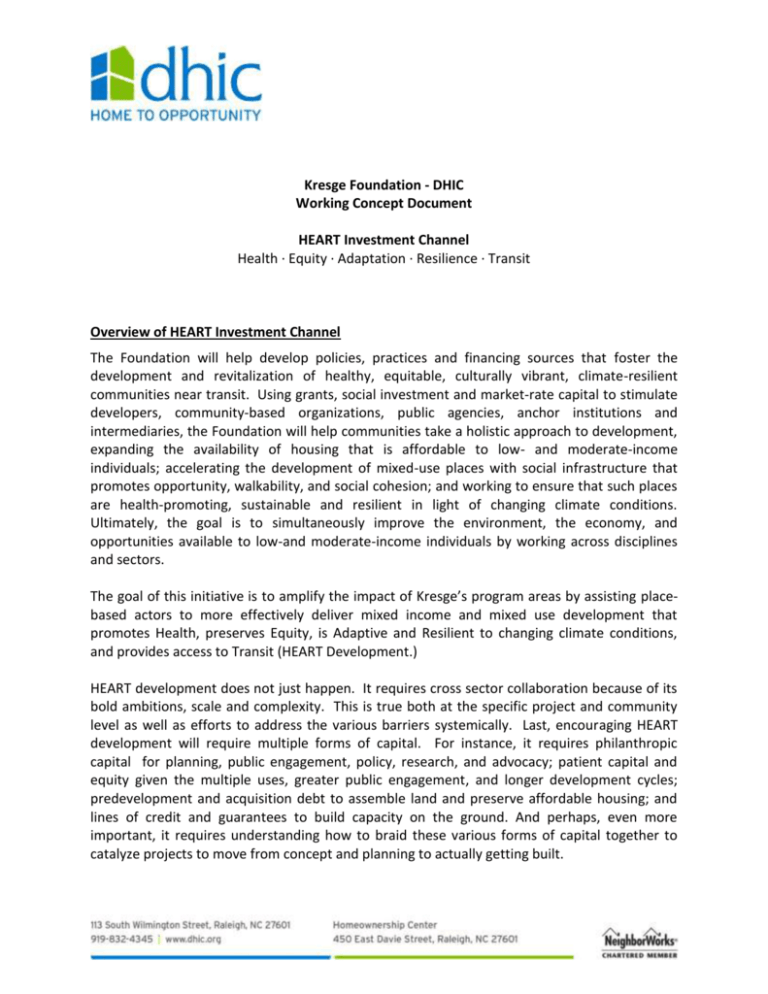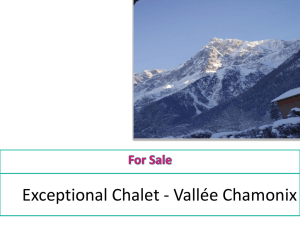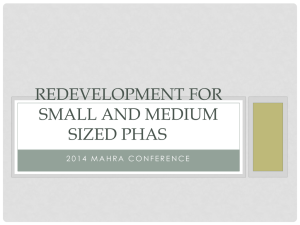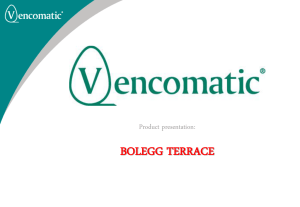Working Concept
advertisement

Kresge Foundation - DHIC Working Concept Document HEART Investment Channel Health · Equity · Adaptation · Resilience · Transit Overview of HEART Investment Channel The Foundation will help develop policies, practices and financing sources that foster the development and revitalization of healthy, equitable, culturally vibrant, climate-resilient communities near transit. Using grants, social investment and market-rate capital to stimulate developers, community-based organizations, public agencies, anchor institutions and intermediaries, the Foundation will help communities take a holistic approach to development, expanding the availability of housing that is affordable to low- and moderate-income individuals; accelerating the development of mixed-use places with social infrastructure that promotes opportunity, walkability, and social cohesion; and working to ensure that such places are health-promoting, sustainable and resilient in light of changing climate conditions. Ultimately, the goal is to simultaneously improve the environment, the economy, and opportunities available to low-and moderate-income individuals by working across disciplines and sectors. The goal of this initiative is to amplify the impact of Kresge’s program areas by assisting placebased actors to more effectively deliver mixed income and mixed use development that promotes Health, preserves Equity, is Adaptive and Resilient to changing climate conditions, and provides access to Transit (HEART Development.) HEART development does not just happen. It requires cross sector collaboration because of its bold ambitions, scale and complexity. This is true both at the specific project and community level as well as efforts to address the various barriers systemically. Last, encouraging HEART development will require multiple forms of capital. For instance, it requires philanthropic capital for planning, public engagement, policy, research, and advocacy; patient capital and equity given the multiple uses, greater public engagement, and longer development cycles; predevelopment and acquisition debt to assemble land and preserve affordable housing; and lines of credit and guarantees to build capacity on the ground. And perhaps, even more important, it requires understanding how to braid these various forms of capital together to catalyze projects to move from concept and planning to actually getting built. Five Pillars of HEART: Planning and Implementation: Support cross-sector organizing and planning to achieve the shared vision, support, and financial resources critical to achieving HEART Development in specific places to serve as proof points. Capital Investment: Develop capital tools that encourage, complement and streamline available public and private capital resources and financing mechanisms. Capacity Building: Build institutional capacity in the public, private, and non-profit sector to imagine, make decisions around, resource and create HEART development. Data & Research: Gather and develop a set of data and diagnostic tools that help assess the assets and barriers to achieving HEART development and the social and economic benefits of doing so. Policy Development: Inform and inspire policy that prioritizes and facilitates HEART development at the local, state and federal levels. DHIC Projects that Fit the Bill Washington Terrace Located in Southeast Raleigh, quadrant of Raleigh with greatest concentration of AA and poverty. But like many communities that developed in the segregated South, it has pockets of neighborhoods with large well-kept homes that served the professional class. WT has a great history. 1950. First housing for African American professionals. Everyone in SE Raleigh knows WT. Opportunity to capture that history through interviews and old photographs. 25 acre site has potential for significant impact and to set standard for future redevelopment in adjacent neighborhoods. Development will include affordable and market rate rental and homeownership housing, playgrounds, community buildings, child care center, village green and community gardens and perhaps more supporting non-residential uses. Adjacent anchor institution is St. Augustine’s University (HBCU). Other anchors or supporting institutions include Boys and Girls Club, Wake County Public School System Alternative HS, YMCA satellite location, and City of Raleigh Parks & Rec facilities Near St. Augustine’s new public health center that will be utilized by Inter-Faith Food Shuttle to offer cooking and nutrition classes and on-site community garden. WT site complements and leads other planned projects and redevelopment, including 150+ City owned parcels to the south and new YMCA Branch planned within a 2 mile radius. . Proximity to LISC-funded federally qualified health center; opportunity to include residents in effort to improve access to and utilization of primary healthcare services. Continuing DHIC commitment to build green, healthy communities. Enterprise Section 4 grant has helped us support this effort WT easily embeds five pillars: Robust community-engaged master planning process, with multiple cross-sector partners at the table Ample opportunity for diverse capital investment across 5-7 phases and 7-10 years, plus secondary projects that may arise adjacent to the parcel The project is building DHIC’s internal planning capacity and that of partners and neighborhood residents—NeighborWorks CLI will help, looking for other ways to build permanent capacity to address complex issues of gentrification and community economic development. Myriad data and research opportunities, from social and economic indicators and shifts; systems change affecting a variety of racial equity indicators; gentrification; links between health and housing, etc. Policy development: relationship with the City of Raleigh and need to coordinate goals and objectives is raising lots of issues; as is the role of federal and state funding and funding priorities (ie: sustainability features and LIHTC) ; infrastructure policies and incentives also an issue. Challenges that HEART Investment Channel Can Help Solve 1. Helping to ensure the redevelopment remains true to community needs and goals while also responding to funding opportunities/trends and sustainability needs and goals. 2. Support for mixed income mixed use varies—NCHFA against. City for. Requires a segmented strategy. 3. Multiple phases that require up-front, risky predevelopment investments that tie up DHIC’s capital. 4. Need for inexpensive yet patient capital, matching funds, flexible funding…various gaps that cannot be planned for in every circumstance. 5. Tension between redevelopment and need or goal to retain the character and demographics of the area—fight against gentrification that drives away African American residents. Young white hipsters are more likely to be in a better position to access moderate-income homeownership opportunities than neighborhood residents (historic privilege, assets, credit-readiness). 6. Funding for innovative Green features, including solar or other alternative energy components, high-level LEED features, and programmable open space (re: community gardens, exercise facilities), is limited with tax credit rules unless other funding sources cover capital costs. 7. Area is not a “food desert” but healthy food options are limited. Some opportunities to improve healthy food access through adjacent privately-owned commercial assets, community gardens, partnerships with high-capacity organizations such as the Interfaith Food Shuttle, Farmers FoodShare, the Raleigh City Farm, and Grocers on Wheels, a mobile fresh produce truck that serves low-income communities. 8. Neighborhood commercial center is limited and neighbors would like to see it maximized for their benefit. Opportunity to collaborate or incentivize redevelopment, but requires working with private property owner. Tricky. 9. DHIC’s chief core competencies are in housing development, asset management and related resident services, so the project requires high-level service and/or ownerpartners to ensure value-added services hit the mark. DHIC needs help as it builds capacity to vet, select, measure and monitor childcare and health care operators 10. DHIC wants the project to meet Health and Housing goals, a connection also being explored by the YMCA and St Augustine’s. What can we reasonably do to explore and prove the connection? This kind of longitudinal data collection and monitoring is expensive and not a core competency. DHIC’s Goals in Participating in HEART Investments 1. Reduce DHIC’s financial risk while ensuring Washington Terrace is a HEART Community. 2. Provide enhanced support services to our residents leading to reduced turnovers and enhanced bottom line results. 3. Create financial efficiencies across the master plan such that innovative programs and features can be added to it. 4. Build internal capacity for connecting our development work with measurable, relevant resident outcomes. 5. Build our capacity for collective impact with anchor stakeholders/high-capacity partners. 6. Bring the learnings of our experience at Washington Terrace the balance of the DHIC rental portfolio. 7. Prepare to illustrate to the NC Housing Finance Agency the benefits of mixed income mixed use strategy with enhanced resident support systems. Agency leadership will be changing—the QAP can be changed. Potential Uses of Funds Grants 1. Expand or replicate Advance Health Care (FQHC) collaboration already in place with LISC. Washington Terrace is not currently included in the effort. Could also connect this effort to other properties where DHIC has some scale (multi-phase properties like Water Garden). 2. Build on partnership with Inter-Faith Food Shuttle and NCSU’s A PACKed Kitchen— expansion of Cooking Matters classes; measure outcomes. 3. Create oral history and/or walking history of the area—in partnership with NCSU’s public history project and St. Augustine’s communications and media programs. 4. On site resident services coordinator dedicated to Washington Terrace and neighborhood as it populates. 5. Grants for amenities, open space and facilities that may not be included in development financing---child care, open space, community gardens. 6. Funds for ongoing planning, including community engagement with residents, stakeholders, partners, anchors. 7. Additional staff at DHIC level to coordinate partnership and documents outcomes of HEART strategy. 8. Deliberate exploration of gentrification—convening, whitepapers, etc. 9. Support for financial capability program for WT and CP residents to prime pump for homeownership. 10. Examination room in common area to support healthcare collaboration 11. Office for County housing specialist (supporting stabilization of fragile populations) 12. Demonstration kitchen for education re: nutrition, cooking, etc. 13. Fitness programming and rooms as well as open space (see below) including measured walking trail 14. Transit improvements such as covered bus shelters designed and built by local artists; build on existing bike route adjoining property Loans 1. Replace existing $3mm land loan at 5% interest with 1% interest rate loan generating $120,000 per year in savings. Can invest this savings in staff and other capacity to manage and monitor soft services/resident outcomes 2. $2 million in infrastructure development financing 3. Financing to incentivize or create redevelopment opportunities for adjacent commercial strip. Could include acquisition down the road. 4. Financing to ensure success of childcare center—social impact bond opportunity? 5. Funds for lot release fees associated with creating open space. 6. Enterprise level funding multiple purposes/predevelopment. 7. $500,000 low interest loan to existing Washington Terrace commercial to redevelop the property. Guarantees 1. Need guarantee or source of low-cost funds for construction financing for homeownership product. Revolver with low costs that could be used for infrastructure costs before home construction starts. 2. Operating reserve guarantees (or similar tool) to free up project cash for resident services or other programs. Expanding Impact to the DHIC Portfolio Intergenerational DHIC Communities While Washington Terrace is DHIC’s largest planned community, there are other larger scale rental communities that DHIC has developed that would benefit from the ideas being tested at Washington Terrace. The communities all feature two or more tax credit communities that individually serve either families or seniors. These projects include: Highland Village, Cary NC. Mixed income community featuring 278 homes including 3 tax credit communities, a 48-unit homeownership community and a common amenities package offering a community clubhouse with swimming pool and fitness center and a village green. Wakefield Manor and Commons, Raleigh, NC. Located in an opportunity neighborhood (a planned community of 5,000 homes featuring a PGA golf course), this LIHTC community includes a 96 unit seniors complex and 80 apartment homes for families. Water Garden, Raleigh, NC. Water Garden is one of DHIC’s newest LIHTC community that includes 60 apartment homes for families and 88 for seniors. Each of these communities have sufficient size and attributes to continue to test the models developed at Washington Terrace and give DHIC the opportunity to carry these strategies across the DHIC portfolio.








